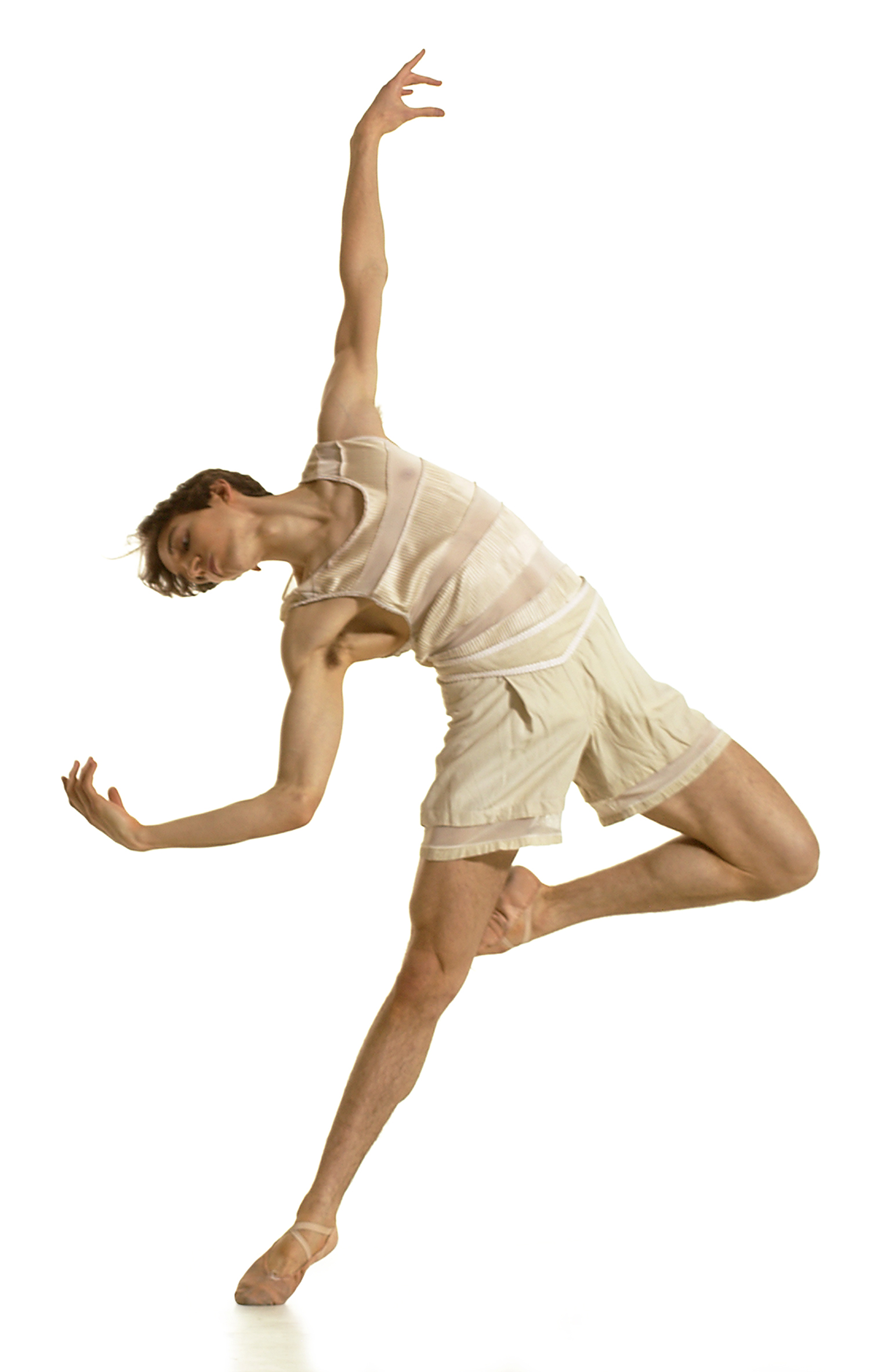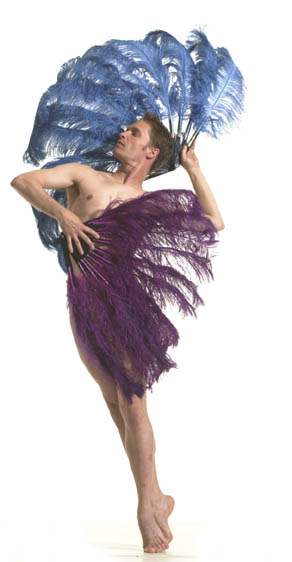Dance Review: Incomplete “Metamorphosis,” Awesome “Awedville”
Two new ballets from the James Sewell company are uneven but dazzling in places.


James Sewell Ballet dances “Metamorphosis” and “Awedville”, Sunday, May 2,
at the O’Shaughnessy Auditorium in Minneapolis
Imagine being this vulnerable: a steel hoop hangs from a harness over a
vacant stage. From the hoop, suspended by her straddled legs, hangs a woman;
she revolves slowly. Now a second woman embraces the first around her waist
and is embraced by her; she lifts her pointed feet into a leap. Together the
two women spin above the stage, barely clothed, abandoned by all other
dancers, unsupported by a space-age soundtrack.
What are you risking?
But let’s start at the beginning. “Metamorphosis,” the first piece in this three-part performance, doesn’t risk much. If the James Sewell Ballet and the Twin Cities Gay Men’s Chorus (which commissioned the work) performed
this coming-out story in the rural south, they’d be politically daring, but
even relocating this preachy work away from its choir wouldn’t make it
artistically risky. Blame the lyrics: “I am, by far much stronger. . . /
when words and feelings are one” is a sample chosen nearly at random. “Love
gives us eyes to see. . . the possibility / of all we can be” leads to the
thrilling conclusion: “finally / I can fly! / Just watch me fly!”
Banal lyrics don’t have to spoil a show, but they do here; the chorus enunciates so well there’s no chance you’ll miss a cliché, and Sewell’s choreography merely acts out the words. Perhaps Sewell and the TCGMC felt the need, in the current political climate, to make a statement about tolerance. I
understand the desire. But, while art can start anywhere, it has to go
somewhere to become art; it has to discover. With its flat, predictable
story and lyrics, this piece comes off as a choral soap opera, with dancers
as interpreters. The audience applauded vigorously the day I went to see the
performance, but this shallow “Metamorphosis” won’t convert anyone who
doesn’t already believe what it preaches.
The second piece, “Water Death” (choreographed by Wynn Fricke), takes place in deep water, far below the safety of the surface. Dancers struggle, toss, and roll, bound in currents they can’t control or understand. The drowning death becomes a metaphor for all kinds of submersion–the panic of being alone, the pressure of others, even the loss of will love requires, that
passionate helplessness, grabbing and turning away and being caught again
(enacted with heart-breaking timing by Penelope Freeh and Benjamin Johnson).
Somehow these ballet-bent bodies, out of control and out of sync, are doubly
moving; you can almost feel the sacrifice of technique. A breathy soundtrack
governs the tidal motion of the dance, as an ensemble gives way to a single
dancer, one is joined by a second, and then a series tumble across the
stage. The arcs of arms and legs induce a trance state–but then, as abruptly
and mysteriously as the vision began, it ends. I wanted more; I wanted
sustained encounter, a deepening and a direction to the trance. Fricke
creates a zone for an event, a rich weave of theme, music, emotion, and
shape, but what takes place here? It’s as if Fricke is so wary of overt
statement that she won’t let the piece test its voice. That’s her risk; to
speak.
For Sewell and co-choreographer Sally Rousse, as evidenced in the powerful, frustrating “Awedville,” the risk is trust. “Awedville” springs from two ideas: first, to stage a postmodern vaudeville show with the Sewell dancers
(and guest aerialist Nina Black). This is a brilliant idea. Sewell gives us
more than glitz: as Black dangles, spins, and goes through her poses,
illumined by one quiet light, pre-classical religious music fills the
darkness of the stage, so that her circus routine becomes a meditation, an
acrobatics of faith. Mischievous dancers puncture and tear apart a sincere
clown, revealing a paint-faced waif (Penelope Freeh) who shyly imitates
their steps. The fan dancer (a delightful Matthew Keefe) is male, not
female, and he uses his wings not only to flirt, but also to buoy his leaps;
it’s the classical Bluebird set free. There’s virtuoso juggling from
Benjamin Johnson, and then Annette (Peggy Seipp), who begins as a human
marionette, then gets loose and makes the aerial leap mentioned above. When
the lights went down on Seipp and Black clinging to each other, turning
slowly in a limbo between sky and earth, reality and dream, the audience
hushed, and awed applause began.
Unfortunately, this perfect ending isn’t the ending of “Awedville,” because Sewell and Rousse insist on a second idea as well: they want to disrobe the performers, to get under the surface of the showmanship. I suppose this is
meant to make the characters more real to us, but all it does is reduce them
to familiar types. We see Annette’s constraint, and then we see her escape
into dangerous freedom; she could be any of us; why, then, specify her
(through voice-over) as a woman imprisoned by fifties-era housewife codes?
Sewell and Rousse’s visionary dances already embody inner states; it’s
intensely disappointing when they back up a beautifully-imagined inner state
with a mediocre story. In the real ending of “Awedville,” the Janitor
(Justin Leaf), uncertain about his sudden fame, sings a quavering rendition
of “There’s No Business Like Show Business,” while all around him the
performers strip off their gold costumes, showing the taut underbellies of
show biz. Then, gaining courage, they endorse the song’s message with tired
smiles, and “Awedville” concludes with a human chain passing gold show-hats
to the aerialist, who’s properly bored as she flourishes them. This obvious
overstatement doesn’t do justice to what came before.
But “Awedville” remains a success. It wounds with beauty; it’s off-kilter, strange, rich. Vaudeville becomes a metaphor for the postmodern inner life, in which we all feel freakish and exploited, but also spot-lit and gifted. The props and the costumes (both the work of Mary Hansmeyer) aid the dream atmosphere, and the music deepens and complicates what goes on onstage.
“Awedville” is also a very new ballet, premiered barely a month ago. There’s
time for Rousse and Sewell to cut away what’s unoriginal and easy, and to
concentrate instead on the risks, on the raw, unhinging vision.
Both in “Awedville” and in “Metamorphosis,” the work’s emotions are
projected onto the body of Justin Leaf. It’s a long, graceful body, mobile,
lovely in a well-balanced attitude turn–but Leaf seems somehow not there.
(That’s understandable, given the painfully sincere characters he portrays.)
Leaf does much better when he’s just dancing, not being asked to ground a
work; he doesn’t yet have that kind of presence. Penelope Freeh’s dancing
shares the reserve of Wynn Fricke’s choreography: she has something to show
us, but she doesn’t have enough time. Her Clown/Ballerina (from “Awedville”)
emerges from her clown suit in a childlike, vulnerable state, seeking a
guide among the other dancers. Then she imitates one dancer and disappears,
her problem apparently solved. Freeh can’t fit the vision that propels her
into the space allowed. It’s a loss to the audience, as her time on stage
hints at deep complexity.
Peggy Seipp finds a middle ground between her
interpretation and the demands of the choreography. Her dancing shines:
long-limbed and graceful, she’s also precise and sure. Her acting is bodily
rather than intellectual, arising out of steps rather than back-story. She
inhabits Annette with (successively) anger, self-hatred, fragility, and a
capacity for awe. Bright and lovely, Seipp also opens her dance to the dark
that surrounds her.
Photos by Joseph D. O’Leary